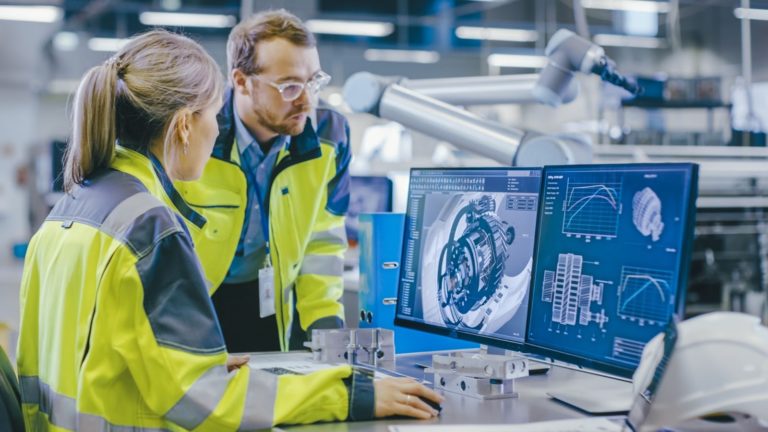Technology plays an integral part in manufacturing. To stay on the leading edge of the industry, manufacturers keep a constant watch on technology trends and advancements coming down the pipeline. Pre-pandemic, manufacturing companies were afforded more time to monitor the progress of new technologies and more resources to adopt the latest, greatest (and perhaps costliest!) options. Fast-forward to the present, and the world is inside of a high-velocity digital transformation. Manufacturers may be able to leverage the accelerated transformation more than they think, but taking advantage of these opportunities requires a careful balance of investment intel, cost management, and strategic planning.
What technologies are trending in the manufacturing industry?
Artificial Intelligence (AI), Augmented Reality (AR) applications, Internet of Things (IoT), enterprise integration, and cloud migration, for starters. Why? Over time, these technologies can drive growth and increase efficiency, production, and the bottom line. They have great potential for a positive return on investment. Manufacturers are operating in an era built on wireless connectivity, where 5G allows for flexible, high-speed manufacturing. Making these investments in digital transformation can allow you to perform factory floor activities, such as production schedules, performance assessments, supply maintenance, from virtually anywhere.
Universal Robots sold the first collaborative mobile robot, or cobot, to a Danish manufacturing company in 2008. These AI-enabled robots work alongside, rather than in place of, human employees. In 2012, cobots entered the U.S. market, and the technology continues to improve manufacturing at home and abroad. While industrial robots are costly and difficult to program, cobots provide a more affordable option that is also versatile because AI allows them to adapt as they perform tasks. Cobots can perform tasks, such as applying pressure, welding, fastening, or making cuts, consistently for every run, which means they can improve your products and processes. And since they improve efficiency and productivity, reduce safety hazards, and supplement labor resources without eliminating factory jobs, manufacturers are choosing to adopt the technology more and more. According to Emergen Research, the global market for cobots, which reached USD 680.3 million in 2019, will grow at an estimated rate of 38.5%, reaching USD 9,342.8 million by 2027.
AR applications can show machine operators fuel levels or general maintenance issues in real-time and may even allow them access to basic on-the-spot repair instructions. IoT technology allows a network of sensors to communicate with cloud software, so manufacturers can access insights on things like equipment performance and the way employees are interacting with their equipment. In today’s atmosphere promoting a remote workforce, cloud migration and enterprise integration help manufacturers connect pertinent data and user-friendly applications across in-house and remote devices.
How can manufacturers manage costs to support smart investments?
Understandably, the focus for many manufacturers has been short-term survival instead of a digital transformation. Short-term plans often start with cost-cutting. As it turns out, your meticulous cost management efforts thus far may already have your company well on its way to long-term exponential benefits.
Manufacturers may be able to minimize expenses for things like travel or overnight delivery. Pay attention to employee expense claims to ensure they fall under your company reimbursement policy. Review your contract obligations to ensure you are getting the best value possible on things like utilities or equipment leasing. Your vendors and suppliers may be willing to renegotiate pricing. Look at general operations and procedures to assess for missed opportunities to increase efficiency.
Keep track of your COVID-19 related costs, as you may qualify for certain grants or tax credits that require documentation to support your need. Ensure you’re up-to-date on applicable legislative provisions that could help your company, such as those pertaining to the Paycheck Protection Program (PPP), Emergency Injury Disaster Loans (EIDLs) and EIDL advances, or the Employee Retention Credit (ERC). And keep an eye on future tax breaks, such as the 100% deduction allowable for business-related food and beverage expenses for 2021 and 2022. You want to keep meticulous records now, so you’re able to receive the maximum benefit later.
If times are tough, eliminating discretionary spending is advised, but balancing cash savings with investments is an art. Manufacturers need cash flow projections and forecasts to stay ahead of deficits and manage shortfalls as well as assess liquidity needs, borrowing capacity, and room for the right investments.
How can the professionals at ARB add value to my cost management and investment?
At ARB, we can help your company with projections and forecasts, which include an investment in a digital transformation. We perform cost accounting reviews to help manufacturers break down fixed and variable costs to enhance their overall pricing strategy and identify areas for efficiency gains. We can help your company with inventory cost management by capturing appropriate inventory costs, including overhead, and helping with pricing strategies and profitability analyses.
There are opportunities for manufacturers to save through our tax credit planning services as well. We provide a proactive approach to harvest all available tax credits available to you. Manufacturers may qualify for the Employee Retention Credit, R&D Tax Credit, Work Opportunity Tax Credit, New Markets Tax Credit, or credits for business energy property, opportunity zone investments, and more.
My team can also help your company take advantage of additional tax relief established by the CARES Act, COVID-Related Tax Relief Act (COVIDTRA), and the Consolidated Appropriations Act, 2021 (CAA).
ARB’s Manufacturing Services Group is dedicated to helping companies like yours consider new means for success and industry-proven methods to meet your unique needs. Contact me today to discuss your company’s digital transformation strategies for investing and managing costs.
by Holly Ferguson, CPA

Holly Ferguson joined ARB in 1996 and has been a principal for the firm since 2012. As the Practice Leader of ARB’s Manufacturing and Accounting & Attest Services Teams, she is well-informed on industry-specific accounting and attests to needs and reporting requirements. Throughout her career, Holly has provided manufacturers with financial reporting consulting services, assisted with transactional accounting and consulting related to business acquisitions/sales, and analyzed implications and strategic implementation of new accounting standards. She is the former Treasurer on the Board of Directors and Finance Committee of the Manufacturers Association of Maine.






